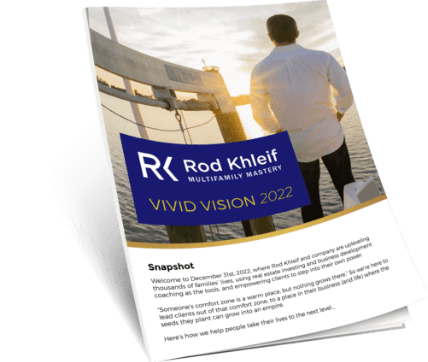Understanding the Personal Financial Statement
Real Estate investing is a team sport and it’s important to leverage the collective power of the deal team to get a deal done. Whether the team is looking to finance a multifamily deal or to market themselves to potential brokers and sellers, it’s necessary to provide a thorough and accurate accounting of their individual and collective financial condition. The easiest way to do this is through the creation of a Personal Financial Statement (PFS).
Personal Financial Statement – Defined
A Personal Financial Statement is a document that contains a detailed accounting of an investor’s assets, liabilities, and income and it’s used to provide evidence of financial strength and/or ability to close on a deal. In a multifamily transaction, providing a Personal Financial Statement serves two purposes:
1. It demonstrates the ability to support a loan if necessary: In multifamily lending, there are two types of debt, Recourse and Non-Recourse. If a lender requires that a deal have “recourse” it means that they require the personal guarantee of the principal(s) in the loan transaction. Providing a guarantee gives the lender the legal means to pursue the personal assets of the loan “guarantor(s)” should a deal go bad. In a non-recourse deal, there are no personal guarantees.
To ensure that the guarantors have the personal capability to repay a loan, the lender will ask them to provide a Personal Financial Statement. As a general rule of thumb, a lender wants to see post transaction liquidity of at least 10% of the loan amount2 and post transaction net worth of 100% of the loan amount. If there are multiple guarantors, these rules apply to them collectively.
2. It inspires Broker/Seller Confidence: The other purpose of a Personal Financial Statement is to inspire confidence in brokers and sellers that an investor has the financial wherewithal to close on a deal.
 For both of these reasons, it’s a good idea to complete – and maintain – a Personal Financial Statement for yourself and to encourage each of the members of your deal team to do the same.
For both of these reasons, it’s a good idea to complete – and maintain – a Personal Financial Statement for yourself and to encourage each of the members of your deal team to do the same.
Personal Financial Statement Categories – Defined
As part of this post, and in an effort to add value, we’ve created a Personal Financial Statement template for you to use as part of your approach to brokers and lenders. To assist in the completion of it, let’s go through each of the categories in the PFS and define what belongs in each of them.
Sponsor / Guarantor Information
The “Sponsor / Guarantor Information” section is used to identify each of the loan sponsors and/or guarantors in the deal. If you’re sponsoring a deal jointly with a spouse, complete the PFS jointly. If you’re sponsoring a deal collectively with multiple general partners, each sponsor should complete their own PFS.
The purpose of this section is to give the lender/broker/seller a good idea of who’s involved in the transaction, where they’re from and what sort of employment they have. To complete it, fill out the name, address, driver’s license, and employment information.
Assets
An asset is property owned by a person or company that has value and can be converted to cash to help meet their financial obligations. Half of the PFS is devoted to detailing sponsor/guarantor assets in the following categories:
Liquidity
Liquidity is the most important category on the PFS because: (1) the funds are readily available to support a loan or make a down payment; and (2) values are easily verified through account or brokerage statements. Traditionally, liquidity consists of the following categories:
- Cash in Banks: Cash in Banks consists of all cash held in checking, savings, money market, or certificate of deposit accounts at a financial institution. The value of the cash listed should be supported by account statements.
- Securities Owned: The Securities Owned category consists of all publicly held marketable securities owned by the sponsor(s)/guarantor(s). It includes all publicly traded stocks and bonds or anything that can be readily converted to cash in a short period of time. It does not include privately held securities that don’t have an established market or readily identifiable buyer. The value listed for securities owned should be supported by brokerage account statements.
- Cash Value of Life Insurance: If any of the loan sponsor/guarantors own a life insurance policy that has a cash surrender value, it should be listed in this category. The cash surrender value should be supported by account statements.
When applying for a loan, the combined, post-transaction liquidity on the loan guarantors should be equal to 10% of the loan amount. For example, if the loan is for $1,000,000, then the guarantors should be able to demonstrate a combined $100,000 in liquidity after they’ve made the down payment on the property.
Long Term Assets
Long term assets are generally considered to be a non-liquid asset that is held for more than one year. When evaluating a loan request, lenders are generally less interested in long term assets because their value is more difficult to prove and they may be difficult to convert to cash. Long term assets are categorized into the following groups:
- Retirement Accounts – Vested Balance: The vested balance for all retirement accounts, such as 401Ks or IRAs, should be listed in this category and supported by account statements. If you’re unsure what the vested balance of your account is, check with your employer and they’ll provide it.
- Notes and Receivables: If you’re owed money by another person or entity, it should be listed in this category. For example, it’s common for a sponsor or guarantor to “loan” money to one of their business entities. As long as it’s documented with a promissory note, it should be included in this category.
- Primary Residence: The value of the sponsor/guarantor’s primary residence should be listed in this category. The value should be based on a verifiable third party estimate such as an appraisal or valuation website, not a “guess”. A lender will check to confirm the value and you don’t want to be wrong.
- Secondary Residence / Vacation Homes: If any of the sponsors or applicants own a secondary residence and/or vacation home, it should be listed in this category. Like the primary residence, the valuation estimate should be verifiable through a 3rd party and supported by recent sales comps.
- Other Real Estate Owned: If any of the sponsors or guarantors own other types of real estate such as land, ranches, or home lots it should be listed in this category. Again, the value should be supported by a 3rd party estimate, but in this case it may be harder to come by. If it is, you should be clear about the methodology used to arrive at the value.
- Real Estate Investments and Partnerships: This category is particularly relevant for multifamily investors. It should include the value of all real estate investments such as partnerships, limited partnerships, interests in an LLC, and individually owned properties through an LLC. As with the other real estate categories, the stated value should be rooted in verifiable fact and the valuation methodology should be clear. The listed value should include only the portion of the investment owned by the sponsor/guarantor. For example, if a sponsor owns 20% of a $1,000,000 property, the listed value should be $200,000, not $1,000,000.
- Businesses Owned: If any of the loan sponsors or guarantors own a non-real estate business or a portion of a business, the estimated value should be listed in this category. A business can be notoriously difficult to value so be clear about the valuation methodology used.
- Personal Property: Lastly, any sort of personal property with a substantial value should be included in this category. It may include things like art, collectibles, automobiles, boats, or furniture. Because it’s difficult to independently verify the value of these assets, a best estimate should be listed.
Total assets are calculated as total liquidity plus long term assets. Next, let’s look at the other half of the PFS.
Liabilities
A liability is an obligation of the sponsor/guarantor, meaning that it’s money owed to a person or entity. Liabilities comprise the other half of the Personal Financial Statement and consist of the following categories:
- Loans Against Securities: On occasion, a sponsor/guarantor may take out a loan against the securities listed in asset category #2. If this is the case, the balance should be listed in this category and it should be supported by loan statements.
- Loans Against Insurance Policies: Because insurance policies often have a cash value, sponsors/guarantors may borrow against them to raise investment capital for real estate projects. If this is the case, list the balance this category and provide supporting documentation in the form of loan statements.
- Loans Against Retirement Accounts: A common way to finance the equity contribution in a multifamily transaction is to borrow against a retirement account such as an IRA or 401k. If this is the case, list the outstanding balance this category and provide supporting documentation in the form of loan statements.
- Loans Against Primary Residence: If there is a mortgage on the primary residence of the sponsor/guarantor, list the outstanding balance in this category and provide supporting loan statements.
- Loans Against Secondary Residence/Vacation Homes: If there are loans against a secondary residence or vacation home, list the outstanding balance in this category and provide supporting statements.
- Loans Against Other Real Estate: If there are loans against any of the “Other Real Estate” assets listed in asset category #8, list the outstanding balance in this category and provide supporting statements.
- Credit Cards Payable: List all outstanding credit card balances this category. The balance listed should be current as of the date of the PFS and supported by equally current credit card statements.
- Loans Payable: If there are any other loans payable that aren’t listed as part of the categories above such as a car or boat loans, list them in this category and provide supporting statements.
Total liabilities are calculated as the sum of all liability categories.
Net Worth
Net worth is calculated as total assets minus total liabilities and it’s one of the key figures that a broker/lender will be looking for. In a loan transaction, the collective net worth of the loan guarantors should be equal to the loan amount. But, net worth doesn’t always tell the entire story of the sponsor/guarantor financial profile. Often there are “contingent” liabilities – that must also be listed – that tend to muddy the net worth picture of the sponsor/guarantor picture.
Contingent Liabilities
For multifamily investors, especially those who own multiple properties, the concept of a “contingent liability” is a critically important component in the lender’s analysis of a guarantor/sponsor financial profile. A contingent liability is defined as an indirect obligation of the borrower/guarantor. In other words, it’s another loan that is personally guaranteed by the sponsor/guarantor. They represent “hidden” risk for the lender because a sponsor or guarantor’s liquidity could be materially reduced if they have to step in and support one of those loans.
Contingent liabilities are very common with real estate investors as they often guarantee multiple loans at once. As such, lenders pay close attention to contingent liabilities and they should be listed as part of the PFS.
If you’d like to go one step further, itemize each of the loans guaranteed and place them in one of the following categories for the lender:
Unrealizable: Unrealizable contingent liabilities are loan guarantees on high performing properties that show no signs of weakness. As such, it’s considered highly unlikely that you’d have to step in and support the loan.
Potentially Unrealizable: Potentially Unrealizable contingent liabilities are associated with properties that are performing, but may show some signs of weakness such as increasing vacancies or declining rents. It’s unlikely that you’d have to step in to support the loan, but not impossible.
Potentially Realizable: Potentially Realizable contingent liabilities are associated with properties that may show signs of sustained underperformance or vacancy. It’s possible that you’d have to step in to make partial or full loan payments.
Realizable: Realizable contingent liabilities are associated with poorly performing properties that have negative NOI. It’s likely that the property will go into foreclosure and that you’ll have to either make loan payments from your own pocket or pay the difference between the liquidated value and the loan balance. If you categorize any of your liabilities as realizable, it’s wise to go a step further and detail a turnaround plan as this is the category that a lender will pay the closest attention to. 
Income / Expenses
If the purpose of the Assets/Liabilities section is to determine the net worth of the sponsor/guarantor, then the purpose of the Income/Expense section is to demonstrate that they have significant, recurring income that could also be used to support the loan if needed.
Complete the income section by listing all sources of income including salary, bonuses, commission, rental income, dividends, capital gains, and partnership income and provide supporting documentation such as W2s, 1099s, or K-1s. Often, full time real estate investors don’t have a traditional salary. Instead, they rely on multiple income sources to pay their bills so it’s important to demonstrate substantial income to qualify for a loan or show financial strength to a broker or seller.
Next, complete the expenses section by listing all recurring expenses including taxes, mortgage payments, association fees, insurance, alimony, child support, tuition, and living expenses.
Total annual income less total annual expenses equals net annual cash flow for the year. If you’re applying for a loan and this figure is negative, it’s going to be important to explain why and how the next year will be different (e.g. you’ll realize a significant gain when selling a property).
Other Information
Lastly, there is some additional information that a lender, broker, or seller may like to know about the individuals involved in the transaction and this is the section in which to state it. If you’ve ever been involved in a bankruptcy or audit, it should be noted. In addition, if there are any outstanding tax obligations, Letters of Credit, or other past due obligations, they should be listed and detailed to give the lender/broker/seller additional color on the situation.
“…if there are any outstanding tax obligations, Letters of Credit, or other past due obligations, they should be listed and detailed to give the lender/broker/seller additional color on the situation.”
Summary/Conclusions
A Personal Financial Statement is a critical document that demonstrates your financial condition to potential lenders and brokers.
In advance of applying for a loan or submitting an offer, it’s a best practice to complete one, including all supporting documentation, and to provide it to the broker/lender as evidence of your ability to close on a deal or support a loan in the event of a bankruptcy.
If possible, it’s ideal to pursue non-recourse debt where an individual guarantee isn’t needed. If it isn’t possible, a Personal Financial Statement should be created and updated annually.
Glossary of Key Terms
Personal Financial Statement: A Personal Financial Statement is a document that contains a detailed accounting of an investor’s assets and liabilities and it’s used to provide evidence of the investor’s financial strength and/or ability to close on a deal
Asset: Property owned by a person or company that has value and can be converted to cash to help meet financial obligations.
Liability: An obligation or money owed to another person or entity.
Net Worth: An indicator of a sponsor/guarantor’s wealth. It’s calculated as total assets, minus total liabilities.
Recourse Debt: A loan in which a personal guarantee is required of the loan sponsors/guarantors.
Non-Recourse Debt: A loan in which no personal guarantee is required.
Loan Guarantor: An individual or group of individuals who personally pledge responsibility for a loan balance in the event of bankruptcy or foreclosure.
Contingent Liability: An indirect obligation of the sponsor/guarantor.




